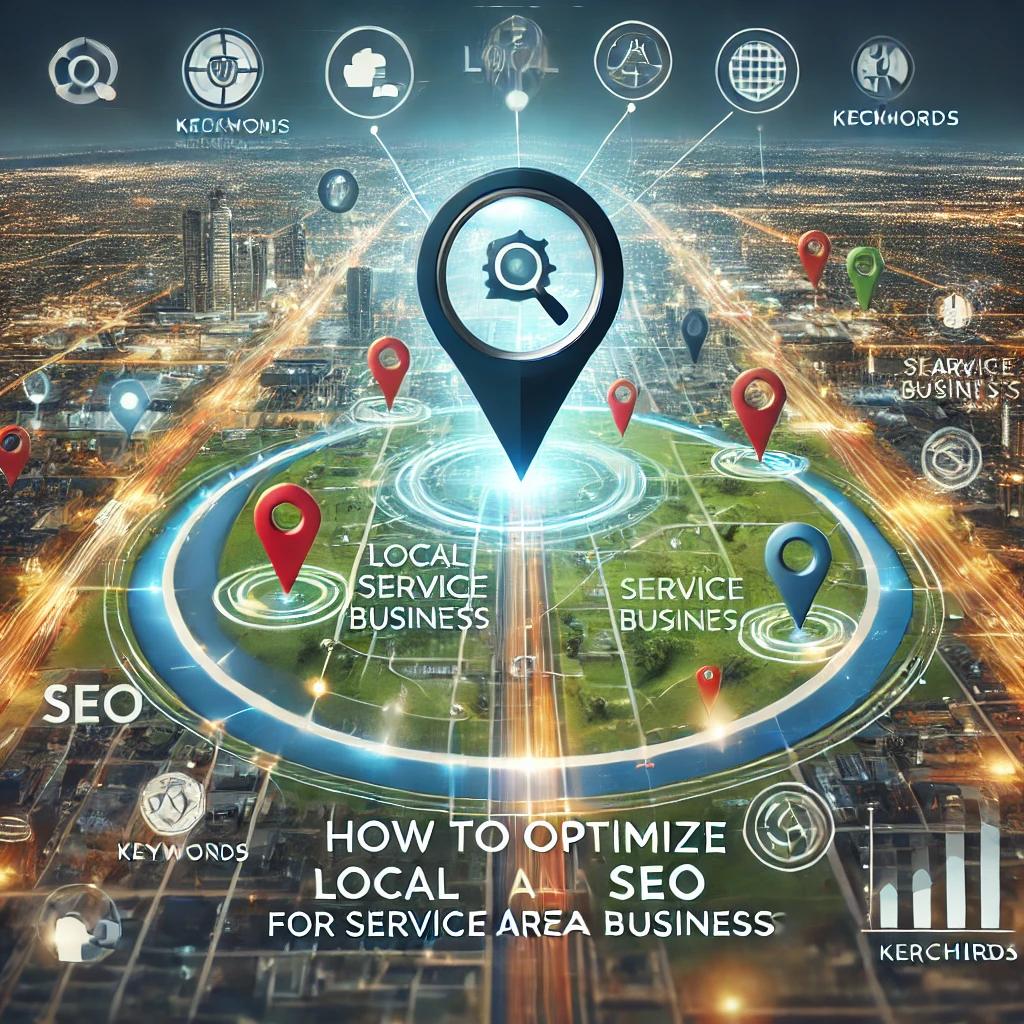How to Optimize Local SEO for Service Area Businesses
Local SEO Optimization is a game-changer for service area businesses (SABs). It’s a powerful tool that helps them connect with their target audience and boost visibility in their service areas

But what exactly is local SEO? It’s a subset of SEO that focuses on optimizing a website to be found in local search results. These results are based on the geographical location of the searcher. For SABs, local SEO is crucial. Why? Because these businesses don’t operate from a fixed location. Instead, they provide services at the customer’s location.
Examples include plumbers, electricians, and home cleaning services. These businesses need to be visible in the areas they serve. And that’s where local SEO comes in. It helps SABs increase their online visibility in specific geographical areas. This, in turn, attracts more local customers. Ultimately, it can significantly boost revenue.
But how can SABs effectively optimize their local SEO? This comprehensive guide provides the answer. It offers actionable insights and step-by-step instructions. Whether you’re a business owner or a marketing professional, this guide is for you. It’s time to take your local SEO to the next level. Let’s dive in.
Understanding Local SEO for Service Area Businesses
Local SEO is a strategic process. It’s designed to improve a business’s visibility in local search results on search engines.

When a user performs a local search, the search engine displays results that are most relevant to their location. This is where local SEO comes into play. It helps businesses promote their products and services to local customers at the exact time they’re looking for them online. This is particularly important for service area businesses (SABs).
The Importance of Local SEO for SABs
For SABs, local SEO is not just important, it’s essential. Why? Because these businesses operate in specific geographical areas. They don’t have a physical storefront that customers can visit. Instead, they travel to their customers’ locations to provide services. This could be anything from plumbing and electrical work to home cleaning and landscaping.
Without a physical location to attract customers, SABs rely heavily on local SEO. It helps them reach potential customers in the areas they serve. By optimizing for local SEO, SABs can increase their online visibility. This leads to more service calls, more customers, and ultimately, more revenue.
Differences Between SABs and Brick-and-Mortar SEO
While the core principles of SEO apply to both SABs and brick-and-mortar businesses, there are key differences. Brick-and-mortar businesses have a physical location. This location is often central to their SEO strategy. They aim to attract customers to their store or office. On the other hand, SABs don’t have a physical location that customers can visit.
Their business model is based on providing services at the customer’s location. Therefore, their local SEO strategy is different. It’s focused on demonstrating their relevance and authority in the areas they serve. Understanding these differences is crucial for SABs to effectively optimize their local SEO.
Setting Up Your Google My Business Profile
Google My Business (GMB) is a free tool. It allows businesses to manage their online presence across Google. This includes Search and Maps.
By verifying and editing your business information, you can help customers find you. You can also tell them the story of your business. For SABs, GMB is a crucial part of local SEO strategy. It’s the first step towards improving your online visibility. It helps you appear in local search results and Google Maps. It also provides potential customers with important information about your business.
Step-by-Step Guide to Google My Business Setup
Setting up your GMB profile is straightforward.
Here’s a step-by-step guide:
- Go to the Google My Business website.
- Click on “Manage Now”.
- Sign in with your Google account.
- Enter your business name.
- Choose the appropriate category for your business.
- Add your service areas.
- Provide your contact information.
- Finish and verify your business.

Each step is important. Make sure to provide accurate and complete information. This will help Google understand your business better. It will also provide potential customers with the information they need.
Optimizing Your GMB Profile for Maximum Visibility
Once your GMB profile is set up, it’s time to optimize it.
Here are some tips:
- Add high-quality photos of your work.
- Include a detailed business description.
- Update your business hours regularly.
- Respond to reviews promptly and professionally.
Optimizing your GMB profile is an ongoing process.
It’s not a one-time task. Regular updates and active management are key to maintaining a strong online presence. This will help you stand out in local search results.
NAP Consistency Across the Web
NAP stands for Name, Address, and Phone number. These are critical pieces of information for your business. They should be consistent across all online platforms.

Inconsistent NAP information can confuse potential customers. It can also negatively impact your local SEO. Search engines like Google use NAP information to determine your business’s legitimacy.
What is NAP and Why Does It Matter?
NAP is a fundamental aspect of local SEO. It helps search engines verify your business’s existence. It also provides them with key details about your business. When your NAP information is consistent, it strengthens your business’s credibility. This can improve your ranking in local search results. Inconsistent NAP information, on the other hand, can harm your SEO efforts.

How to Ensure NAP Consistency
Ensuring NAP consistency involves a few key steps:
- Audit your online presence to identify any inconsistencies.
- Update any incorrect or outdated information.
- Use the same format for your NAP across all platforms.

Remember, even small discrepancies can cause problems. For example, “St.” and “Street” are not considered consistent. Maintaining NAP consistency requires regular audits and updates. This will help you maintain a strong local SEO presence.
On-Page Local SEO Optimization
On-page SEO is a crucial part of local SEO optimization. It involves optimizing elements on your website to improve visibility. This includes your content, meta tags, and images. It also includes your website’s structure and internal linking. On-page SEO helps search engines understand your website. It also helps them determine its relevance to a searcher’s query.
Key On-Page Elements to Optimize
There are several key on-page elements to optimize for local SEO:
- Title tags: Include your target local keywords.
- Meta descriptions: Write compelling descriptions with local keywords.
- Headers: Use headers to structure your content and include local keywords.
- Content: Create high-quality, locally relevant content.
Optimizing these elements can improve your website’s visibility. It can also enhance the user experience. Remember, a well-optimized website is more likely to rank higher in search results.
Creating Locally Relevant Content
Creating locally relevant content is key to local SEO. This type of content resonates with your local audience. It also helps search engines understand your local relevance. For example, you could write blog posts about local events or news. You could also create location-specific pages on your website.
This can help you rank for local keywords. It can also provide valuable information to your local customers. Remember, the more locally relevant your content, the better your chances of ranking in local search results.
Leveraging Local Keywords
Local keywords are vital for local SEO optimization. They help search engines understand your local relevance.

They also help you connect with customers in your service area. Local keywords typically include your service and your location. For example, “plumbing services in Manila” or “electrician in Cebu City”.
Identifying and Targeting Local Keywords
Identifying and targeting local keywords requires research.
Here are some steps to follow:
- Use keyword research tools to find local keywords related to your services.
- Look at the keywords your local competitors are targeting.
- Consider the language and terms your local customers use.
Remember, the goal is to find keywords that your local customers are using. These are the keywords you want to target in your local SEO strategy.
Incorporating Local Keywords into Your Strategy
Once you’ve identified your local keywords, it’s time to incorporate them into your strategy. This means using them in your website content, meta tags, and headers.

You should also use them in your Google My Business profile. Remember, the goal is to use these keywords naturally. Don’t overuse them, as this can lead to keyword stuffing, which search engines penalize. Instead, focus on creating high-quality, locally relevant content that naturally includes these keywords.
Managing Online Reviews and Customer Feedback
Online reviews and customer feedback play a crucial role in local SEO. They not only influence your online reputation but also your local search rankings.
Positive reviews can boost your visibility on search engines. They can also help you attract more local customers. On the other hand, negative reviews can harm your online reputation. They can also deter potential customers from choosing your services. Therefore, managing online reviews and customer feedback should be a key part of your local SEO strategy.
The Power of Positive Reviews
Positive reviews can work wonders for your local SEO. They can significantly improve your online visibility.

They can also help you build trust and credibility with your local customers. In fact, many customers check online reviews before choosing a service. Therefore, having a high number of positive reviews can give you a competitive edge. It can also help you attract more customers and increase your revenue.
Responding to Reviews: Best Practices
Responding to reviews, both positive and negative, is crucial. It shows that you value your customers’ feedback.
It also gives you a chance to address any issues or concerns. For positive reviews, thank the customer and express your appreciation. For negative reviews, apologize and offer a solution. Remember, your responses are public. So, always be professional and courteous. This can help you turn a negative situation into a positive one. It can also show potential customers that you care about customer satisfaction.
Building Local Backlinks
Backlinks are a key factor in SEO. They are especially important for local SEO.

Local backlinks can help improve your search engine rankings. They can also increase your online visibility. Moreover, they can help you attract more local customers.
Why Local Backlinks Matter
Local backlinks are links from other local websites to yours. They are seen as a vote of confidence by search engines. This can significantly boost your local SEO. Local backlinks can also drive relevant traffic to your website. This can lead to more inquiries and sales. Therefore, building local backlinks should be a key part of your local SEO strategy.
How to Acquire Quality Local Backlinks
Acquiring quality local backlinks requires a strategic approach.
Here are a few effective strategies:
- Partner with local businesses and organizations.
- Sponsor local events or charities.
- Create valuable, shareable content.
- List your business in local directories.
- Participate in local forums and online communities.
Remember, the quality of backlinks is more important than quantity. So, focus on getting backlinks from reputable and relevant local websites. This can help you maximize your local SEO results.
Utilizing Structured Data Markup
Structured data markup is a powerful SEO tool. It helps search engines understand your website content.
This can enhance your visibility on search engine results pages (SERPs). It can also improve your local SEO performance.
What is Structured Data and How to Use It
Structured data is a type of code. It helps search engines interpret your website content. This can lead to rich search results, including star ratings, images, and other details.
Here are a few types of structured data relevant to local SEO:
- Local business schema
- Review schema
- Event schema
- Product schema
Using structured data can help you stand out in local search results. It can also provide users with valuable information at a glance.
Implementing Local Business Schema
Local business schema is particularly important for local SEO. It provides specific information about your business to search engines. This includes your business name, address, and phone number. It can also include your opening hours, reviews, and more. Implementing local business schema can enhance your local search visibility. It can also improve the accuracy of your business information across the web.
Mobile Optimization and Local SEO
Mobile optimization is a crucial aspect of local SEO. More people are using mobile devices to search for local businesses.
This means your website needs to be mobile-friendly to attract and retain these users.
The Impact of Mobile on Local Search
Mobile search has a significant impact on local SEO. Google uses mobile-first indexing. This means it primarily uses the mobile version of your website for indexing and ranking. If your website isn’t mobile-friendly, it could hurt your local SEO performance. You could lose potential customers to competitors with mobile-friendly websites.
Best Practices for Mobile-Friendly Local SEO
There are several best practices for mobile-friendly local SEO. First, ensure your website is responsive. This means it automatically adjusts to fit the screen size of the device it’s viewed on.
Second, make sure your website loads quickly. Slow loading times can frustrate users and lead to high bounce rates. Finally, ensure your website is easy to navigate on a mobile device. This includes having clear, easy-to-click buttons and a simple, intuitive menu.
Social Media and Local SEO
Social media plays a significant role in local SEO. It can help increase your online visibility and drive traffic to your website.
Moreover, social media platforms often have their own search functions. This means your business can appear in local search results on these platforms.
Leveraging Social Media for Local Visibility
To leverage social media for local visibility, you need to be active on the platforms your target audience uses. This could be Facebook, Instagram, Twitter, LinkedIn, or others. Create and share content that is relevant and valuable to your local audience. Engage with your followers by responding to comments and messages. This can help build relationships and foster loyalty.
Integrating Social Media into Your Local SEO Strategy
Integrating social media into your local SEO strategy involves more than just posting content. You should also use social media to promote your local content, such as blog posts or local news.
Additionally, encourage your followers to leave reviews on your social media profiles. These reviews can boost your local SEO and attract more customers.
Tracking and Analyzing Your Local SEO Performance
Tracking and analyzing your local SEO performance is crucial. It helps you understand what’s working and what’s not.

With this data, you can make informed decisions to improve your local SEO strategy. You can identify areas of improvement and opportunities for growth. Moreover, tracking your performance allows you to measure the return on investment (ROI) of your local SEO efforts.
Key Metrics to Monitor
There are several key metrics you should monitor in your local SEO strategy.
These include:
- Organic traffic: The number of visitors coming to your website from search engines.
- Local search rankings: How your business ranks in local search results.
- Click-through rate (CTR): The percentage of people who click on your website after seeing it in search results.
- Conversion rate: The percentage of visitors who take a desired action on your website, such as filling out a form or making a purchase.
These metrics can provide valuable insights into your local SEO performance.
Tools for Measuring Local SEO Success
There are several tools available to help you measure your local SEO success. Google Analytics is a powerful tool that provides detailed data about your website traffic and user behavior.
Google Search Console can help you understand how Google views your website and identify any issues that might affect your search rankings. Additionally, SEO-specific tools like SEMrush and Moz offer features for tracking local SEO performance. These tools can provide insights into your local search rankings, backlink profile, and more.
Common Local SEO Mistakes to Avoid
Local SEO can be a game-changer for service area businesses. However, it’s easy to make mistakes that can hurt your local SEO efforts.
By being aware of these common errors, you can avoid them and improve your local SEO performance. In this section, we’ll cover some of the top mistakes that can hurt your local SEO and how to correct them.
Top Mistakes That Can Hurt Your Local SEO
Here are some common mistakes that can negatively impact your local SEO:
- Inconsistent NAP information: Your business name, address, and phone number (NAP) should be consistent across all online platforms.
- Ignoring online reviews: Online reviews play a crucial role in local SEO. Ignoring them can hurt your online reputation and search rankings.
- Not optimizing for mobile: With more people using mobile devices to search for local businesses, not having a mobile-friendly website can negatively impact your local SEO.
- Not using local keywords: Failing to use local keywords in your content can make it harder for people to find your business in local search results.
Avoiding these mistakes can significantly improve your local SEO performance.
How to Correct Common Local SEO Errors
Correcting these common local SEO errors is straightforward. Ensure your NAP information is consistent across all platforms. Pay attention to online reviews and respond to them in a timely and professional manner. Make sure your website is mobile-friendly and optimize your content with local keywords. By correcting these errors, you can improve your local SEO performance and increase your online visibility.
Advanced Local SEO Tips and Strategies
Local SEO is not a one-size-fits-all strategy. It requires a tailored approach that considers the unique needs and goals of your service area business.

In this section, we’ll share some advanced local SEO tips and strategies that can help you take your local SEO efforts to the next level. These strategies can help you handle multiple service areas, optimize for seasonal trends, and more.
Handling Multiple Service Areas
If your business serves multiple areas, local SEO can be a bit more complex. You need to ensure that each service area is properly represented and optimized in your local SEO strategy.

One effective strategy is to create separate landing pages for each service area. Each page should be optimized with local keywords and content relevant to that specific area. This can help improve your visibility in local search results for each of your service areas.
Seasonal Local SEO Optimization
Many service area businesses experience seasonal trends. For example, a landscaping business may be busier in the spring and summer months. To capitalize on these trends, you can optimize your local SEO strategy for different seasons.
Here are some tips:
- Update your content: Create blog posts or update service pages to reflect seasonal services or promotions.
- Adjust your keywords: Use keyword research tools to identify seasonal keywords and incorporate them into your content.
- Leverage local events: If there are local events related to your business or industry, consider participating and promoting your involvement online.
By optimizing your local SEO strategy for different seasons, you can attract more local customers when they’re most likely to need your services.
Conclusion and Next Steps
Local SEO is a powerful tool for service area businesses. It can help you increase your online visibility, attract more local customers, and grow your business.
Recap of Key Points
Throughout this guide, we’ve covered a wide range of topics related to local SEO for service area businesses.
We’ve discussed the importance of local SEO, how to set up and optimize your Google My Business profile, the role of NAP consistency, on-page SEO optimization, local keywords, online reviews, local backlinks, structured data markup, mobile optimization, social media, tracking your performance, common mistakes to avoid, and advanced strategies.
Implementing Your Local SEO Plan
Now that you have a better understanding of local SEO, it’s time to put this knowledge into action.
Start by auditing your current local SEO efforts, then use the strategies and tips in this guide to optimize your approach. Remember, local SEO is an ongoing process that requires regular monitoring and adjustments. With time and effort, you can improve your local search rankings, attract more customers, and grow your service area business.


